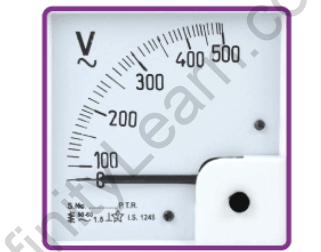Table of Contents
A voltage metre, also known as a voltage metre, is a device that measures the voltage or potential difference between two points in an electronic or electrical circuit. The voltmeter is typically used for Alternating Current (AC) or Direct Current (DC) circuits. Radio Frequency (RF) voltage can also be measured using specialised voltmeters.
Voltages are measured using a voltmeter in volts, millivolts (0.001 volts), or kilovolts (1,000 volts). A voltmeter is connected in parallel to a device to measure its voltage. This configuration is critical because objects in parallel typically experience the same potential difference. It is connected in parallel with the circuit because it experiences the same voltage drop as the circuit. A voltmeter has a high internal resistance as well. This is done primarily to measure the potential difference between the two points of the circuit. As a result, the measuring device’s current remains constant. In other words, the voltmeter’s high resistance will obstruct the flow of current through it. This enables the device to take accurate voltage readings.

Types of Voltmeter
Today, many voltmeters are digital, with numerical displays that show the readings. However, analogue voltmeters are also available, and this type of voltmeter provides readings by moving a pointer in a specific direction to indicate voltage on a scale. Digital voltmeters are preferred over analogue voltmeters because they have a higher order of accuracy. We’ll go over them in more detail below.
Analogue or Analog Voltmeter
An analogue voltmeter is primarily used to measure alternating current voltage. The reading is displayed using a pointer that is fixed on a calibrated scale. The torque acting on the pointer has an effect on its movement. The magnitude of the torque produced is proportional to the voltage being measured. A basic analogue voltmeter is made up of a sensitive galvanometer (current metre) that is part of a high resistance series. The meter’s internal resistance should be high. Otherwise, the circuit operation during the test would be disrupted by a significant draw of current. The meter’s voltage range is determined by the series resistance value and the galvanometer sensitivity.
Digital Voltmeter
The digital voltmeter is another voltage measurement instrument that is widely used. A digital voltmeter (DVM) measures an unknown input voltage by converting it to a digital value and displaying it numerically. DVMs are typically built around a type of analogue-to-digital converter known as an integrating converter. The accuracy of the DVM is affected by a variety of factors, including input impedance, temperature, and power supply voltage variations. The input resistance of the least expensive DVMs is around 10 M. For low voltage ranges, the input resistances for precision DVMs of 1 G or higher (below 20 V). To ensure that the manufacturer’s specified tolerances are met, the DVM must be calibrated on a regular basis with a voltage standard such as the Weston Cell.
FAQs
What is the function of a voltmeter?
A voltmeter is a device that measures the electrical potential difference between two points in an electric circuit. An analogue voltmeter moves a pointer across a scale in proportion to the voltage in the circuit; a digital voltmeter displays numbers.
What is a voltmeter and what types are there?
Voltmeters are classified into two types based on their output: analogue and digital voltmeters. Analog voltmeters use moving needles to display voltage. Digital voltmeters display the voltage as an accurate value on a digital display.






